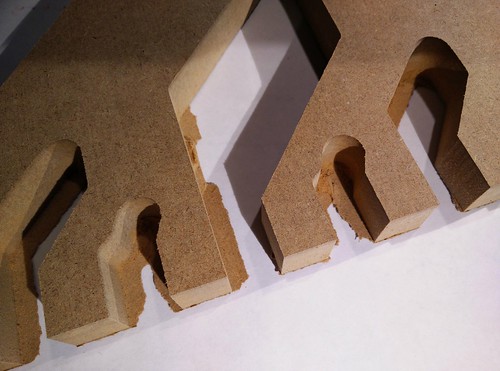Binarytree stool
Binary Tree Foot Stool
 |
 |
My very first Shopbot project at NYC Resistor was a small 30x30 footstool made out of the cheapest MDF in our supply. On the top is a Hilbert curve, which can be etched very quickly with the 45 degree bit. The legs are eight way binary trees that nest into their own pockets. Cutting the pockets took most of the time since the shopbot is very slow at making the round fillets.
Since this is my first design, it has some issues. You can build you own with the files posted as thing:1259080.
 |
 |
Lessons learned on this project:
- Inkscape PDF export generates duplicate lines that VCarve doesn't handle correctly, so use DXF instead.
- Inkscape DXF export is in pts by default, but vcarve wants inches. Be sure to change the Base Unit field when saving as DXF.
- Be sure the Z depth is sufficient to cut through the material. The MDF is 19.5mm, while the fancy ply is 18.5mm (0.75"). The defaults left a little less than a mm of material that I had to clean off with a razor.
- The default fillet setting is a ¼" diameter, but the down-cut bit is ¼" radius. This made the fillets far larger than necessary.
- The shopbot is super fast at cutting straight lines, but very slow with any sort of curves. Cutting fillets took the majority of the time.
- Shopbot's software can't estimate progress -- the fillets were 40% to 50% of the progress meter, but 95% of the actual time.
- People will watch anything on periscope and googly eyes make it go faster.
- If you are bolting down a full sheet of wood, a) have someone help and b) be sure to configure the zero reference as the top of the work piece. You won't be able to get a reading on the spoilboard once the work piece is secured.
- Vcarve doesn't seem to work right with metric measurements. Keep it in inches for now.